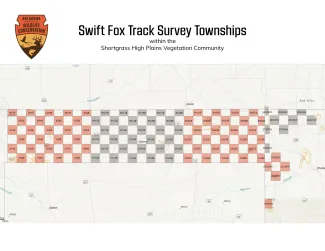Each year, Wildlife Department biologists survey publicly accessible roads in the High Plains ecoregion for signs of Oklahoma’s smallest fox, the swift fox. Alternating townships (6-mile-by-6-mile blocks) within the three-county Panhandle region and portions of Harper and Ellis counties are searched for the triangular tracks of this species of greatest conservation need.

Once surveyors enter their designated township, they search the ground for signs of the swift fox and other mammals. While the fox’s petite 1.25-by-1.5-inch tracks are the focus, scat and living or road-killed foxes are also documented, along with tracks of other carnivores. A township must be actively searched for at least 30 minutes and surveyors can move to the next township if no swift fox tracks have been observed after two hours of active searching. Because time spent traveling within the block is not counted, surveys of each township may take up to four hours to complete.
This year, 19 townships in Beaver County were surveyed during the multi-day sampling period, with swift fox tracks detected in 17 townships.
| Survey Year | Focal County | No. Townships Surveyed | No. Townships Positive for Swift Fox Tracks | No. Townships with Other Swift Fox Evidence |
|---|---|---|---|---|
| 2025 | Beaver | 19 | 17 |
|
| 2024 | Cimarron | 18 | 12 | 1 |
| 2023 | Texas | 28 | 21 | 2 |
